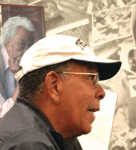From an obscure photo comes a book

Karen Haas has a passion for what she does, as seen by the emotion in her telling of the Gordon Parks story during her Friday presentation to the public.
Haas is the curator for the Lane Collection of Photography at the Boston Museum of Fine Arts.
"She had one photo of two young black kids in front of a movie theater," Jill Warford, executive director of the Gordon Parks Museum at Fort Scott Community College said in an interview.

"We had the picture and nobody knew anything about it. It was dated 1949, it was actually 1950. I don't know much, but I knew it wasn't New York City," Haas said.
"That photo piqued her interest and she got in contact with the Gordon Parks Foundation in New York," Warford said. "They put her in contact with the Gordon Parks papers at Wichita State University, then us, too. They found the Life Magazine draft."
Warford and Haas began emailing back and forth and Haas came to Fort Scott earlier this year to glean all the information she could from area residents.
"We helped her a lot to track down information," Warford said.
The culmination of all this detective work will be a book about Gordon Parks and the stories of his classmates, slated for publication in January. The book, "Gordon Parks: Back to Fort Scott," will be available at the Gordon Parks Museum and on Amazon and other book outlets, Haas said. The Boston Museum of Fine Arts, in conjunction with the Gordon Parks Foundation, is in the process of mounting an exhibit, of the photos, along with the book.
Haas's presentation
For the Gordon Parks Celebration, Haas brought the collection of 80 photographs that Parks took for a photo essay on his classmates from Fort Scott's all black Plaza School circa 1950.
"In 1950 Gordon Parks was offered by Life Magazine to do a story on segregated schools," Haas said. "Kansas is at the epicenter of this. It's just before Brown versus the Board of Education."
Brown v. Board of Education is a landmark U.S. Supreme Court decision that ended legal segregation in public schools in 1954.
"Life Magazine gave him the job of finding his 11 elementary classmates," Haas said. "He goes back (to Fort Scott) a very different man from the scared and saddened boy at the death of his mother. He is beginning to make a name for himself."
Upon his return in 1950, Parks finds Fort Scott is also different.
"Fort Scott was 20 percent African American when he left. It was down to 6 percent (in 1950)," Haas said.
But the Great Migration made it difficult to find his 11 classmates.
The Great Migration occurred from 1916 to 1970, when six million African Americans from rural communities in the south moved to large cities in the north and west, according Encyclopedia Britannica online.
"He only found nine friends in the end," Haas said. "Ira and Emily, he can't find information on these classmates. He was able to find Luella Russell Hill, his classmate still in Fort Scott. He photographed the Hills in front of their house."
Parks set about finding his classmates who left Fort Scott for a better life.
The other classmates were Emma Jane Wells, Margaret Tyson, Mazel Morgan, Pauline Terry, Donald Beatty, Earl Collins, Fred Wells and Peter Thomason.
Three of the classmates Parks found in Chicago, Ill., living in the Black Belt on the city's south side.
One poignant story Haas told of Parks' odyssey is of Mazel Morgan Hubbard, who Parks found married to Willy Hubbard in Chicago.
Parks visited the Hubbards in their dreary room in Chicago and decided to give Mazel some money because they were so destitute.
"Gordon takes the money out of his wallet, and Willy, who's been lying on the bed who's described as ill, suddenly is much better...goes down to the liquor store, spends all the money and they have a party and Gordon can see how this is going," Haas said. "A discouraging experience. The saddest part is when (Parks) goes to leave, apparently Willy pulls a gun on Gordon and Gordon has to give him all the rest of the money.
"He could see how far he'd come and where his roots lay," Haas said. "Even though it didn't appear in Life Magazine, it was an important pivotal point in his career."
Instead of a story of segregated schools, the story became one about The Great Migration, she said.
"This was a two-week's odyssey of finding his classmates. He was driving from city to city," Haas said.
"The story you are telling was really the prelude to 'The Learning Tree,'" David Parks, Gordon's son who was attending the presentation, said.
"The Learning Tree" was a semi-autobiography that was later made into a film which was the first major studio picture to be directed by an African American.
